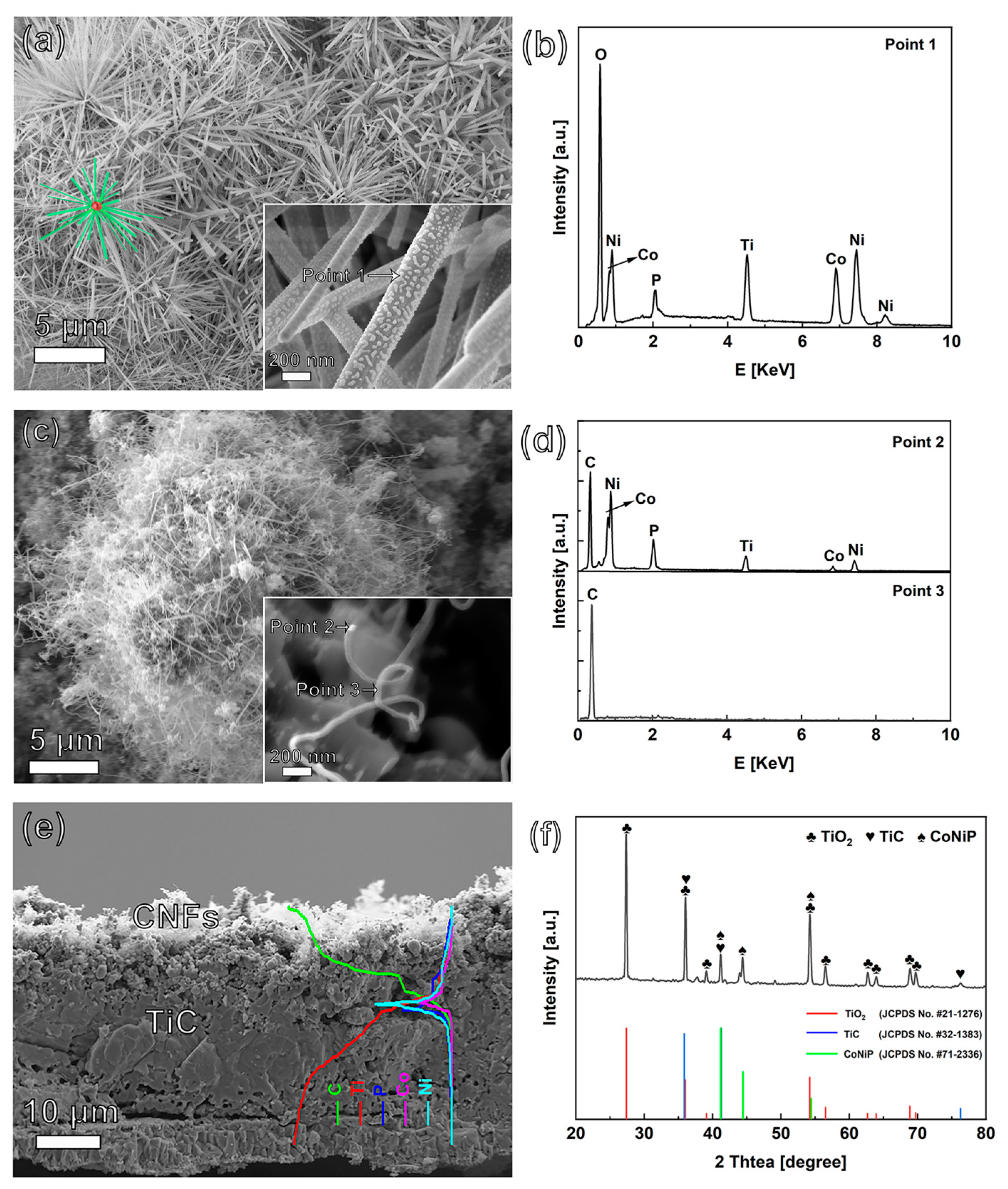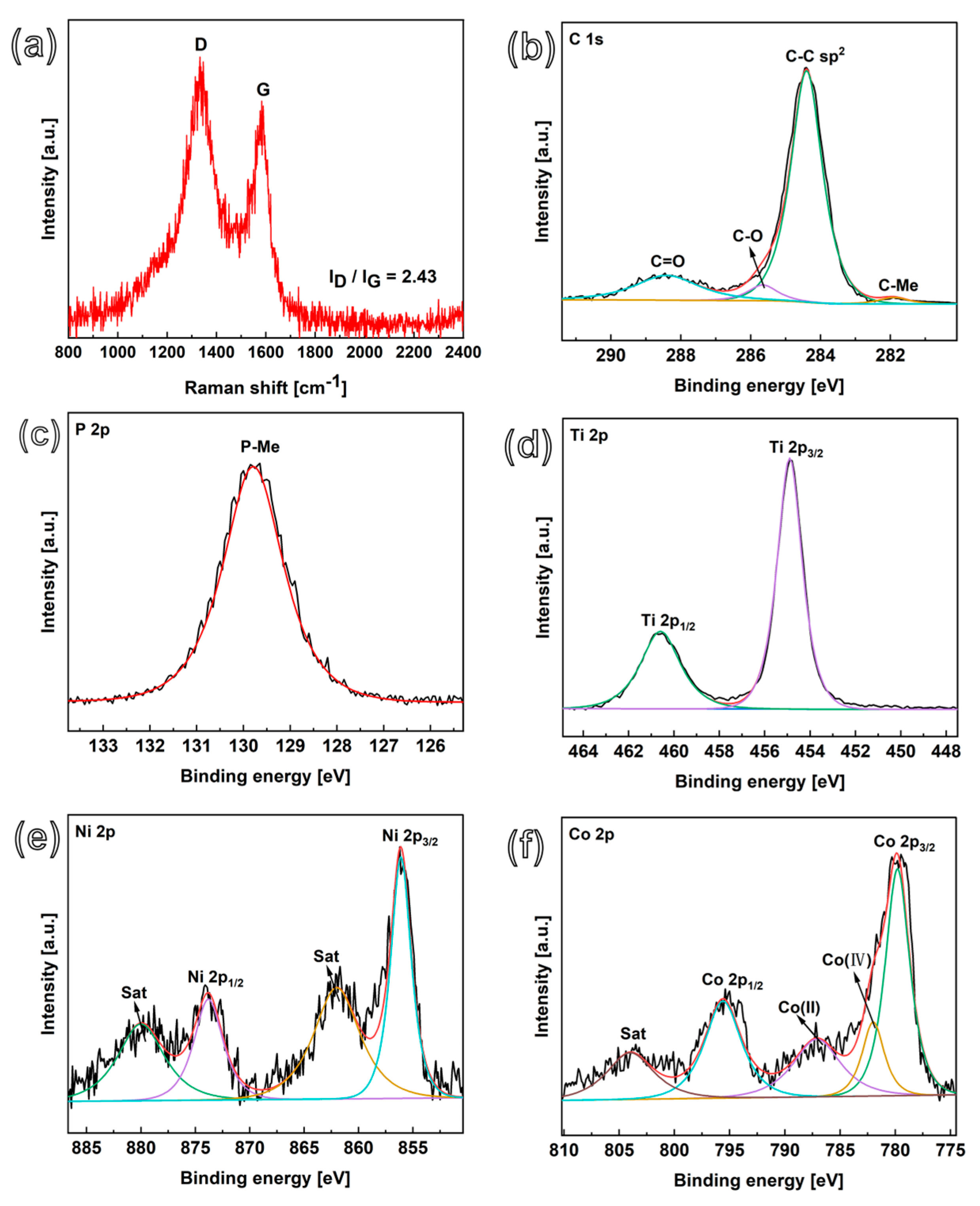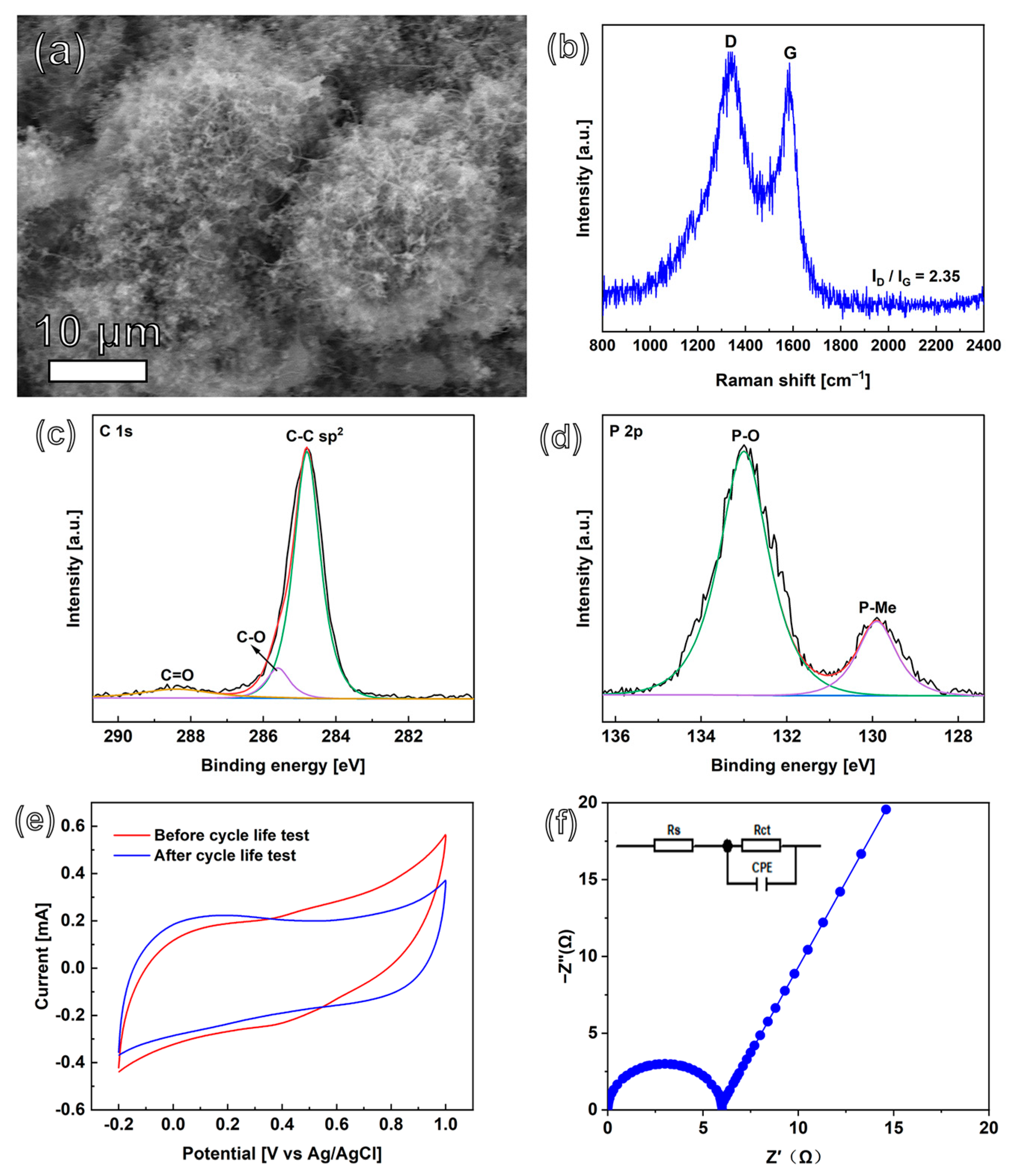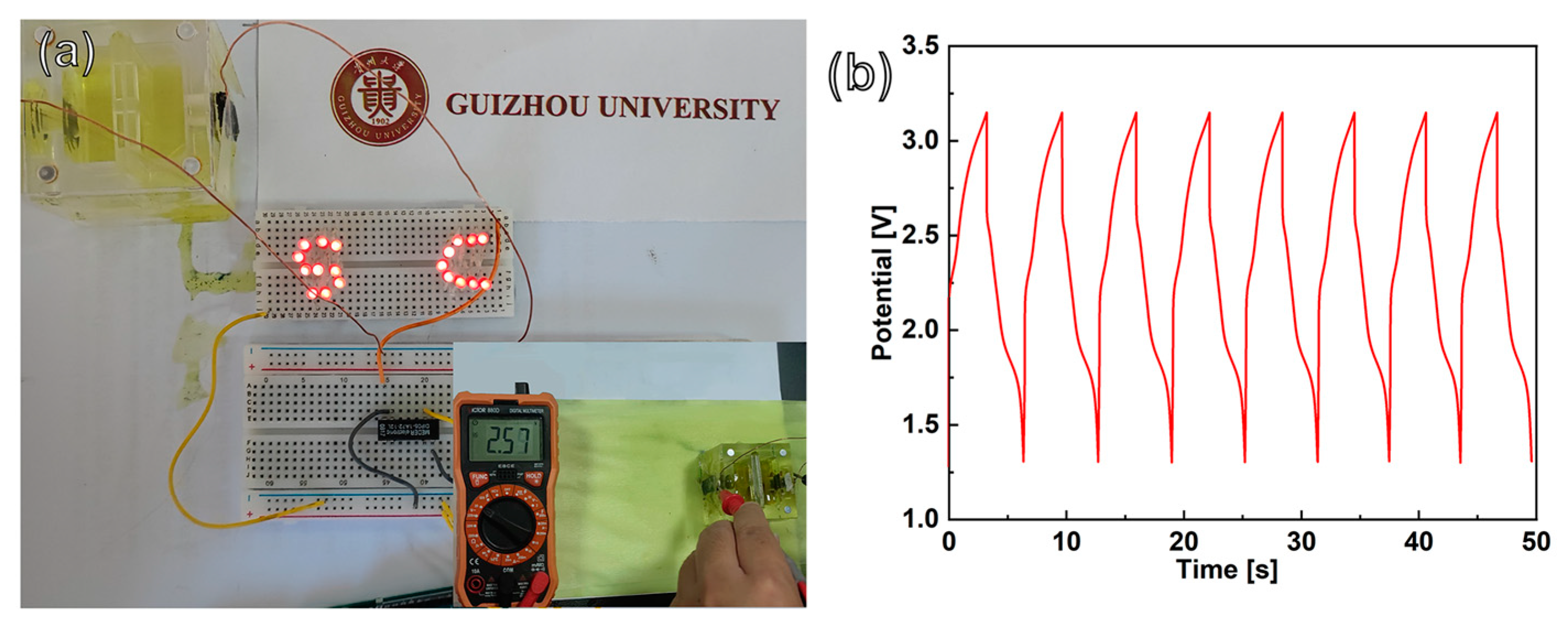Hierarchical Nickel Cobalt Phosphide @ Carbon Nanofibers Composite Microspheres: Ultrahigh Energy Densities of Electrodes for Supercapacitors
Abstract
:1. Introduction
2. Materials and Methods
2.1. Synthesis and Characterization of the Composites
2.2. Electrochemical Measurements
3. Results and Discussion
3.1. Characterization and Growth Mechanism of CoNiP@CNFs Composite Film
3.2. Supercapacitor Performance of CoNiP@CNFs Electrodes
3.3. Cyclic Stability and SC Mechanism
3.4. Energy and Power Densities
4. Conclusions
Supplementary Materials
Author Contributions
Funding
Data Availability Statement
Conflicts of Interest
References
- Zhao, H.; Yuan, Z.Y. Progress and Perspectives for Solar-Driven Water Electrolysis to Produce Green Hydrogen. Adv. Energy Mater. 2023, 13, 2300254. [Google Scholar] [CrossRef]
- Jain, D.; Kanungo, J.; Tripathi, S. Enhancement in performance of supercapacitor using eucalyptus leaves derived activated carbon electrode with CH3COONa and HQ electrolytes: A step towards environment benign supercapacitor. J. Alloys Compd. 2020, 832, 154956. [Google Scholar] [CrossRef]
- Zhang, W.; Li, G. Environmental decentralization, environmental protection investment, and green technology innovation. Environ. Sci. Pollut. Res. 2020, 29, 12740–12755. [Google Scholar] [CrossRef]
- Niu, L.; Wu, T.; Chen, M.; Yang, L.; Yang, J.; Wang, Z.; Kornyshev, A.A.; Jiang, H.; Bi, S.; Feng, G. Conductive metal–organic frameworks for supercapacitors. Adv. Mater. 2022, 34, 2200999. [Google Scholar] [CrossRef]
- Chen, L.; Lu, Y.; Yu, L.; Lou, X. Designed formation of hollow particle-based nitrogen-doped carbon nanofibers for high-performance supercapacitors. Energy Environ. Sci. 2017, 10, 1777–1783. [Google Scholar] [CrossRef]
- Guan, Y.; Hu, K.; Su, N.; Zhang, G.; Han, Y.; An, M. Review of NiS-Based Electrode Nanomaterials for Supercapacitors. Nanomaterials 2023, 13, 979. [Google Scholar] [CrossRef]
- Wu, Y.; Cao, C. The way to improve the energy density of supercapacitors: Progress and perspective. Sci. China Mater. 2018, 61, 1517–1526. [Google Scholar] [CrossRef]
- Kour, P.; Kour, S.; Sharma, A.; Yadav, K. Mixed-phase MoS2 nanosheets anchored carbon nanofibers for high energy symmetric supercapacitors. J. Energy Storage 2023, 63, 107054. [Google Scholar] [CrossRef]
- Senokos, E.; Anthony, D.B.; Rubio, N.; Ribadeneyra, M.C.; Greenhalgh, E.S.; Shaffer, M. Robust Single-Walled Carbon Nanotube-Infiltrated Carbon Fiber Electrodes for Structural Supercapacitors: From Reductive Dissolution to High Performance Devices. Adv. Funct. Mater. 2023, 33, 2212697. [Google Scholar] [CrossRef]
- Zhang, W.; Li, W.; Li, S. Self-template activated carbons for aqueous supercapacitors. Sustain. Mater. Technol. 2023, 36, e00582. [Google Scholar] [CrossRef]
- Fu, M.; Chen, W.; Lei, Y.; Yu, H.; Lin, Y.; Terrones, M. Biomimetic construction of ferrite quantum dot/graphene heterostructure for enhancing ion/charge transfer in supercapacitors. Adv. Mater. 2023, 35, 2300940. [Google Scholar] [CrossRef] [PubMed]
- Worsley, E.A.; Margadonna, S.; Bertoncello, P. Application of Graphene Nanoplatelets in Supercapacitor Devices: A Review of Recent Developments. Nanomaterials 2022, 12, 3600. [Google Scholar] [CrossRef] [PubMed]
- Pan, Z.; Yu, S.; Wang, L.; Li, C.; Meng, F.; Wang, N.; Zhou, S.; Xiong, Y.; Wang, Z.; Wu, Y.; et al. Recent Advances in Porous Carbon Materials as Electrodes for Supercapacitors. Nanomaterials 2023, 13, 1744. [Google Scholar] [PubMed]
- Yu, S.; Yang, N.; Vogel, M.; Mandal, S.; Williams, O.A.; Jiang, S.; Schönherr, H.; Yang, B.; Jiang, X. Battery-like supercapacitors from vertically aligned carbon nanofiber coated diamond: Design and demonstrator. Adv. Energy Mater. 2018, 8, 1702947. [Google Scholar] [CrossRef]
- Jiang, H.; Wang, Y.; Wang, C.; Li, M.; Xu, Z. Catalyst optimization and reduction condition of continuous growth of carbon nanotubes on carbon fiber surface. Ceram. Int. 2023, 49, 25469–25476. [Google Scholar] [CrossRef]
- Ma, Y.; Weimer, C.; Yang, N.; Zhang, L.; Staedler, T.; Jiang, X. Low-temperature growth of carbon nanofiber using a vapor–facet–solid process. Mater. Today Commun. 2015, 2, e55–e61. [Google Scholar] [CrossRef]
- Cui, B.; Wang, C.; Wang, Y.; Wang, C.; Jiang, H.; Li, M.; Xu, Z. In-situ growth of bamboo-like carbon nanotubes from Cu catalyst on continuous carbon fibre for interfacial enhancement. Compos. Sci. Technol. 2023, 234, 109933. [Google Scholar] [CrossRef]
- Kang, J.; Han, R.; Wang, J.; Yang, L.; Fan, G.; Li, F. In situ synthesis of nickel carbide-promoted nickel/carbon nanofibers nanocomposite catalysts for catalytic applications. Chem. Eng. J. 2015, 275, 36–44. [Google Scholar] [CrossRef]
- Ji, H.; Ma, Y.; Cai, Z.; Yun, M.; Han, J.; Tong, Z.; Wang, M.; Suhr, J.; Xiao, L.; Jia, S. Mesoporous Cobalt Oxide (CoOx) Nanowires with Different Aspect Ratios for High Performance Hybrid Supercapacitors. Nanomaterials 2023, 13, 749. [Google Scholar] [CrossRef]
- Bethune, D.S.; Kiang, C.H.; De Vries, M.; Gorman, G.; Savoy, R.; Vazquez, J.; Beyers, R. Cobalt-catalysed growth of carbon nanotubes with single-atomic-layer walls. Nature 1993, 363, 605–607. [Google Scholar] [CrossRef]
- Elsaidy, A.; Majcherkiewicz, J.N.; Puértolas, B.; Salgueiriño, V.; Nóvoa, X.R.; Correa-Duarte, M.A. Synergistic interaction of clusters of iron oxide nanoparticles and reduced graphene oxide for high supercapacitor performance. Nanomaterials 2022, 12, 2695. [Google Scholar] [CrossRef] [PubMed]
- Yoon, C.M.; Jekal, S.; Kim, D.H.; Noh, J.; Kim, J.; Kim, H.Y.; Kim, C.G.; Chu, Y.R.; Oh, W.C. 3D Hierarchically Structured Tin Oxide and Iron Oxide-Embedded Carbon Nanofiber with Outermost Polypyrrole Layer for High-Performance Asymmetric Supercapacitor. Nanomaterials 2023, 13, 1614. [Google Scholar] [PubMed]
- Zheng, T.; Tahmasebi, M.H.; Li, B.; Li, Y.; Ran, S.; Glen, T.S.; Lam, K.H.; Choi, I.S.; Boles, S.T. Sputtered titanium nitride films on titanium foam substrates as electrodes for high-power electrochemical capacitors. ChemElectroChem 2018, 5, 2199–2207. [Google Scholar] [CrossRef]
- Parveen, N.; Cho, M. Self-assembled 3D flower-like nickel hydroxide nanostructures and their supercapacitor applications. Sci. Rep. 2016, 6, 27318. [Google Scholar] [CrossRef]
- Shao, M.; Li, J.; Li, J.; Yan, Y.; Li, R. Synthesis of Ni3S2 and MOF-Derived Ni(OH)2 Composite Electrode Materials on Ni Foam for High-Performance Supercapacitors. Nanomaterials 2023, 13, 493. [Google Scholar]
- Pham, T.N.; Samikannu, A.; Vincze, Z.; Zettinig, P.; Tesfalidet, S.; Wågberg, T.; Mikkola, J.P. Core–Shell Carbon Nanofibers-NiFe Structure on 3D Porous Carbon Foam: Facilitating a Promising Trajectory toward Decarbonizing Energy Production. Adv. Sustain. Syst. 2022, 6, 2200310. [Google Scholar] [CrossRef]
- Zhang, Z.; Ren, Z.; Zhang, S.; Yuan, D.; Dou, Y.; Qiao, Z.; Yu, Z.; Kang, J.; Li, W.; Chou, S. High-yielding carbon nanofibers grown on NIPS-derived porous nickel as a flexible electrode for supercapacitors. Mater. Chem. Front. 2020, 4, 2976–2981. [Google Scholar] [CrossRef]
- Xu, J.; Schulte, A.; Schönherr, H.; Jiang, X.; Yang, N. Hierarchical carbon nanofibers@ nickel phosphide nanoparticles for high-performance supercapacitors. Small Struct. 2022, 3, 2100183. [Google Scholar] [CrossRef]
- Černá, M.; Veselý, M.; Dzik, P. Physical and chemical properties of titanium dioxide printed layers. Catal. Today 2011, 161, 97–104. [Google Scholar] [CrossRef]
- Poudel, M.B.; Kim, A.R.; Ramakrishan, S.; Logeshwaran, N.; Ramasamy, S.K.; Kim, H.J.; Yoo, D.J. Integrating the essence of metal organic framework-derived ZnCoTe–N–C/MoS2 cathode and ZnCo-NPS-N-CNT as anode for high-energy density hybrid supercapacitors. Compos. Part B Eng. 2022, 247, 110339. [Google Scholar] [CrossRef]
- Poudel, M.B.; Kim, A.A.; Lohani, P.C.; Yoo, D.J.; Kim, H.J. Assembling zinc cobalt hydroxide/ternary sulfides heterostructure and iron oxide nanorods on three-dimensional hollow porous carbon nanofiber as high energy density hybrid supercapacitor. J. Energy Storage 2023, 60, 106713. [Google Scholar] [CrossRef]
- Jiang, Y.; Liu, B.; Yang, W.; Yang, L.; Li, S.; Liu, X.; Zhang, X.; Yang, R.; Jiang, X. Crystalline (Ni1− xCox)5TiO7 nanostructures grown in situ on a flexible metal substrate used towards efficient CO oxidation. Nanoscale 2017, 9, 11713–11719. [Google Scholar] [CrossRef] [PubMed]
- Liu, L.; Li, Y.; Meng, Y.; Xue, Y.; Yang, B.; Li, B.; Liu, X. Preparation of nickel-bound porous carbon and its application in supercapacitors. Inorg. Chem. Front. 2022, 9, 652–661. [Google Scholar] [CrossRef]
- Xu, J.; Yang, N.; Yu, S.; Schulte, A.; Schönherr, H.; Jiang, X. Ultra-high energy density supercapacitors using a nickel phosphide/nickel/titanium carbide nanocomposite capacitor electrode. Nanoscale 2020, 12, 13618–13625. [Google Scholar] [CrossRef] [PubMed]
- Trentler, T.J.; Hickman, K.M.; Goel, S.C.; Viano, A.M.; Gibbons, P.C.; Buhro, W. Solution-liquid-solid growth of crystalline III-V semiconductors: An analogy to vapor-liquid-solid growth. Science 1995, 270, 1791–1794. [Google Scholar] [CrossRef]
- Shokouhfar, M.; Dehghanian, C.; Montazeri, M.; Baradaran, A. Preparation of ceramic coating on Ti substrate by plasma electrolytic oxidation in different electrolytes and evaluation of its corrosion resistance: Part II. Appl. Surf. Sci. 2012, 258, 2416–2423. [Google Scholar] [CrossRef]
- Van Thiem, L.; Tu, L.T.; Phan, M.-H. Magnetization reversal and magnetic anisotropy in ordered CoNiP nanowire arrays: Effects of wire diameter. Sensors 2015, 15, 5687–5696. [Google Scholar] [CrossRef]
- Cheng, Y.; Xu, Z.; Han, Y.; Li, X.; Zhang, S.; Sun, S. Fabrication of Sugar-Coated CoNi2S4/Ni3P Nanostructure with Ultrahigh Electrochemical Performance for Supercapacitor Application. Int. J. Electrochem. Sci. 2021, 16, 210440. [Google Scholar] [CrossRef]
- Xu, J.; Yang, N.; Heuser, S.; Yu, S.; Schulte, A.; Schönherr, H.; Jiang, X. Achieving ultrahigh energy densities of supercapacitors with porous titanium carbide/boron-doped diamond composite electrodes. Adv. Energy Mater. 2019, 9, 1803623. [Google Scholar] [CrossRef]
- Pan, G.; Cao, F.; Zhang, Y.; Xia, X. N-doped carbon nanofibers arrays as advanced electrodes for supercapacitors. J. Mater. Sci. Technol. 2020, 55, 144–151. [Google Scholar] [CrossRef]
- Ma, T.; Pan, Y.; Chen, J.; Yan, Z.; Chen, B.; Zhao, L.; Hu, L.; Wen, L.; Hu, M. Synthesis of TiC nanotube arrays and their excellent supercapacitor performance. J. Mater. Chem. A 2022, 10, 9932–9940. [Google Scholar] [CrossRef]
- Liu, Y.; Xiang, C.; Chu, H.; Qiu, S.; McLeod, J.; She, Z.; Xu, F.; Sun, L.; Zou, Y. Binary Co–Ni oxide nanoparticle-loaded hierarchical graphitic porous carbon for high-performance supercapacitors. J. Mater. Sci. Technol. 2020, 37, 135–142. [Google Scholar] [CrossRef]
- Wang, Q.; Miao, H.; Sun, S.; Xue, Y.; Liu, Z. One-Pot Synthesis of Co3O4/Ag Nanoparticles Supported on N-Doped Graphene as Efficient Bifunctional Oxygen Catalysts for Flexible Rechargeable Zinc–Air Batteries. Chem. Eur. J. 2018, 24, 14816–14823. [Google Scholar] [CrossRef]
- Mukhiya, T.; Dahal, B.; Ojha, G.P.; Chhetri, K.; Lee, M.; Kim, T.; Chae, S.H.; Tiwari, A.P.; Muthurasu, A.; Kim, H. Silver nanoparticles entrapped cobalt oxide nanohairs/electrospun carbon nanofibers nanocomposite in apt architecture for high performance supercapacitors. Compos. Part B Eng. 2019, 178, 107482. [Google Scholar] [CrossRef]
- Lei, X.; Shi, Z.; Wang, X.; Wang, T.; Ai, J.; Shi, P.; Xue, R.; Guo, H.; Yang, W. Solvothermal synthesis of pompon-like nickel-cobalt hydroxide/graphene oxide composite for high-performance supercapacitor application. Colloids Surf. A Physicochem. Eng. Asp. 2018, 549, 76–85. [Google Scholar] [CrossRef]
- Saleh, A.A.; Amer, A.; Sayed, D.M.; Allam, N.K. A facile electrosynthesis approach of Mn-Ni-Co ternary phosphides as binder-free active electrode materials for high-performance electrochemical supercapacitors. Electrochim. Acta 2021, 380, 138197. [Google Scholar] [CrossRef]
- Du, C.; Wang, G.; Liu, Z.; Chen, C.; Xie, M.; Chen, J.; Zhang, Y.; Wan, L. Design of B, P co-doped CoNi bimetallic for boosting supercapacitor performance: Effect of boronation and phosphorization order. J. Alloy Compd. 2023, 935, 168147. [Google Scholar] [CrossRef]
- Xu, J.; Li, C.; Yu, S.; Wang, Z.; Pritzel, C.; Jiang, X.; Yang, N. Flexible carbon cloth supercapacitors with high power and energy densities. Energy Technol. 2023, 11, 2300214. [Google Scholar] [CrossRef]
- Poudel, M.B.; Kim, H.J. Confinement of Zn-Mg-Al-layered double hydroxide and α-Fe2O3 nanorods on hollow porous carbon nanofibers: A free-standing electrode for solid-state symmetric supercapacitors. Chem. Eng. J 2022, 429, 132345. [Google Scholar] [CrossRef]
- Agarwal, A.; Sankapal, B. Metal phosphides: Topical advances in the design of supercapacitors. J. Mater. Chem. A 2021, 9, 20241–20276. [Google Scholar] [CrossRef]
- Laheäär, A.; Przygocki, P.; Abbas, Q.; Béguin, F. Appropriate methods for evaluating the efficiency and capacitive behavior of different types of supercapacitors. Electrochem. Commun. 2015, 60, 21–25. [Google Scholar] [CrossRef]
- Simon, P.; Gogotsi, Y. Materials for electrochemical capacitors. Nat. Mater. 2008, 7, 845–854. [Google Scholar] [CrossRef] [PubMed]







Disclaimer/Publisher’s Note: The statements, opinions and data contained in all publications are solely those of the individual author(s) and contributor(s) and not of MDPI and/or the editor(s). MDPI and/or the editor(s) disclaim responsibility for any injury to people or property resulting from any ideas, methods, instructions or products referred to in the content. |
© 2023 by the authors. Licensee MDPI, Basel, Switzerland. This article is an open access article distributed under the terms and conditions of the Creative Commons Attribution (CC BY) license (https://creativecommons.org/licenses/by/4.0/).
Share and Cite
Zhang, J.; Cen, M.; Wei, T.; Wang, Q.; Xu, J. Hierarchical Nickel Cobalt Phosphide @ Carbon Nanofibers Composite Microspheres: Ultrahigh Energy Densities of Electrodes for Supercapacitors. Nanomaterials 2023, 13, 2927. https://doi.org/10.3390/nano13222927
Zhang J, Cen M, Wei T, Wang Q, Xu J. Hierarchical Nickel Cobalt Phosphide @ Carbon Nanofibers Composite Microspheres: Ultrahigh Energy Densities of Electrodes for Supercapacitors. Nanomaterials. 2023; 13(22):2927. https://doi.org/10.3390/nano13222927
Chicago/Turabian StyleZhang, Jinqiao, Meiling Cen, Tao Wei, Qianyun Wang, and Jing Xu. 2023. "Hierarchical Nickel Cobalt Phosphide @ Carbon Nanofibers Composite Microspheres: Ultrahigh Energy Densities of Electrodes for Supercapacitors" Nanomaterials 13, no. 22: 2927. https://doi.org/10.3390/nano13222927
APA StyleZhang, J., Cen, M., Wei, T., Wang, Q., & Xu, J. (2023). Hierarchical Nickel Cobalt Phosphide @ Carbon Nanofibers Composite Microspheres: Ultrahigh Energy Densities of Electrodes for Supercapacitors. Nanomaterials, 13(22), 2927. https://doi.org/10.3390/nano13222927





